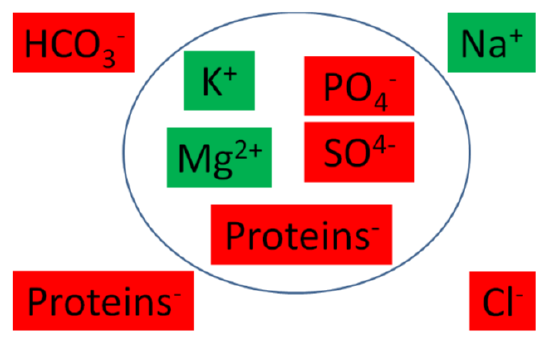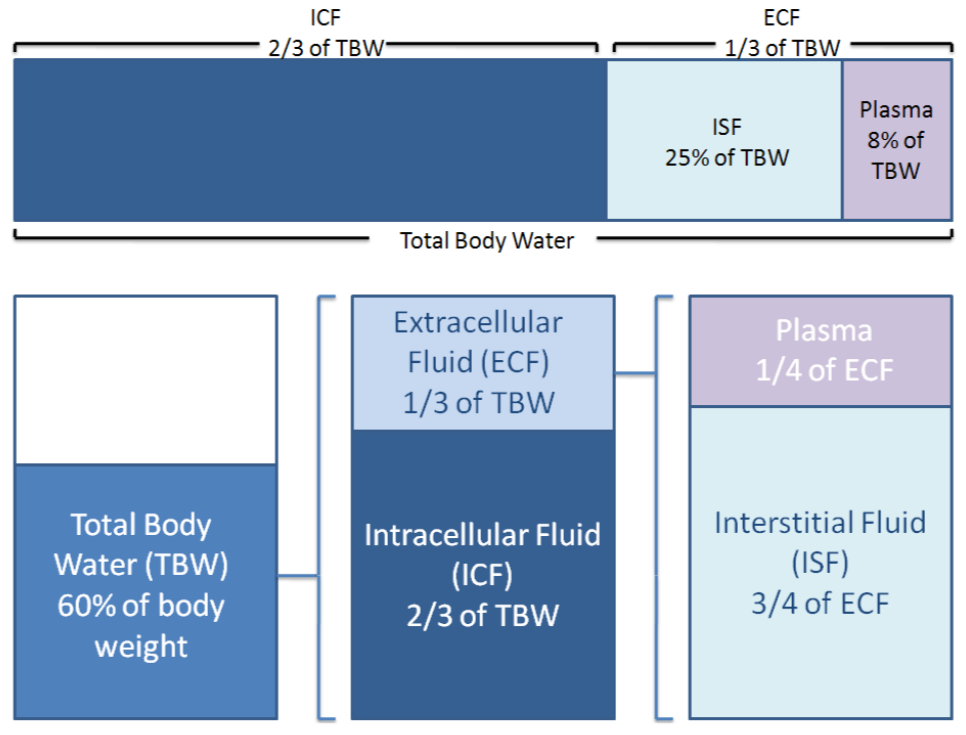13.1: Electrolytes
- Page ID
- 41003
Electrolytes are compounds that separate into ions in water. Electrolytes can be separated into 2 classes:
- Cations: ions that have a positive charge
- Anions: ions that have a negative charge
The following table summarizes the major intracellular and extracellular electrolytes by giving their milliequivalents (mEq)/L. Milliequivalents are a measure of charge. Thus, a higher value means that the cation or anion is accounting for more charge.
| Intracellular | Extracellular | ||
|---|---|---|---|
| Cations | Anions | Cations | Anions |
| Potassium (\(\ce{K+}\)) 150 | Phosphate (\(\ce{PO^4-}\)) 104 | Sodium (\(\ce{Na+}\)) 142 | Chloride (\(\ce{Cl-}\)) 103 |
| Magnesium (\(\ce{Mg^2+}\)) 40 | Proteins 57 | Bicarbonate (\(\ce{HCO^3-}\)) 27 | |
| Sulfate (\(\ce{SO4^2-}\)) 20 | Proteins 16 | ||
The following figure graphically shows the major intracellular and extracellular cations (green) and anions (red).

Figure \(\PageIndex{1}\): Major intracellular and extracellular cations (green) and anions (red)2
Electrolytes and proteins are important in fluid balance. Your body is 60% water by weight. Two-thirds of this water is intracellular, or within cells. One-third of the water is extracellular, or outside of cells. One-fourth of the extracellular fluid is plasma, while the other 3/4 is interstitial (between cells) fluid. Thus, when considering total body water, around 66% is intracellular fluid, 25% is interstitial fluid, and 8% is plasma3,4.
Fluid distribution between the different compartments are shown below.

Figure \(\PageIndex{2}\): Distribution of fluid in the body3,4.
Query \(\PageIndex{1}\)
References
- Byrd-Bredbenner C, Moe G, Beshgetoor D, Berning J. (2009) Wardlaw's perspectives in nutrition. New York, NY: McGraw-Hill.
- Whitney E, Rolfes SR. (2011) Understanding nutrition. Belmont, CA: Wadsworth Cengage Learning.
- Gropper SS, Smith JL, Groff JL. (2008) Advanced nutrition and human metabolism. Belmont, CA: Wadsworth Publishing.
- Adapted from http://www.netterimages.com/image/21248.htm


